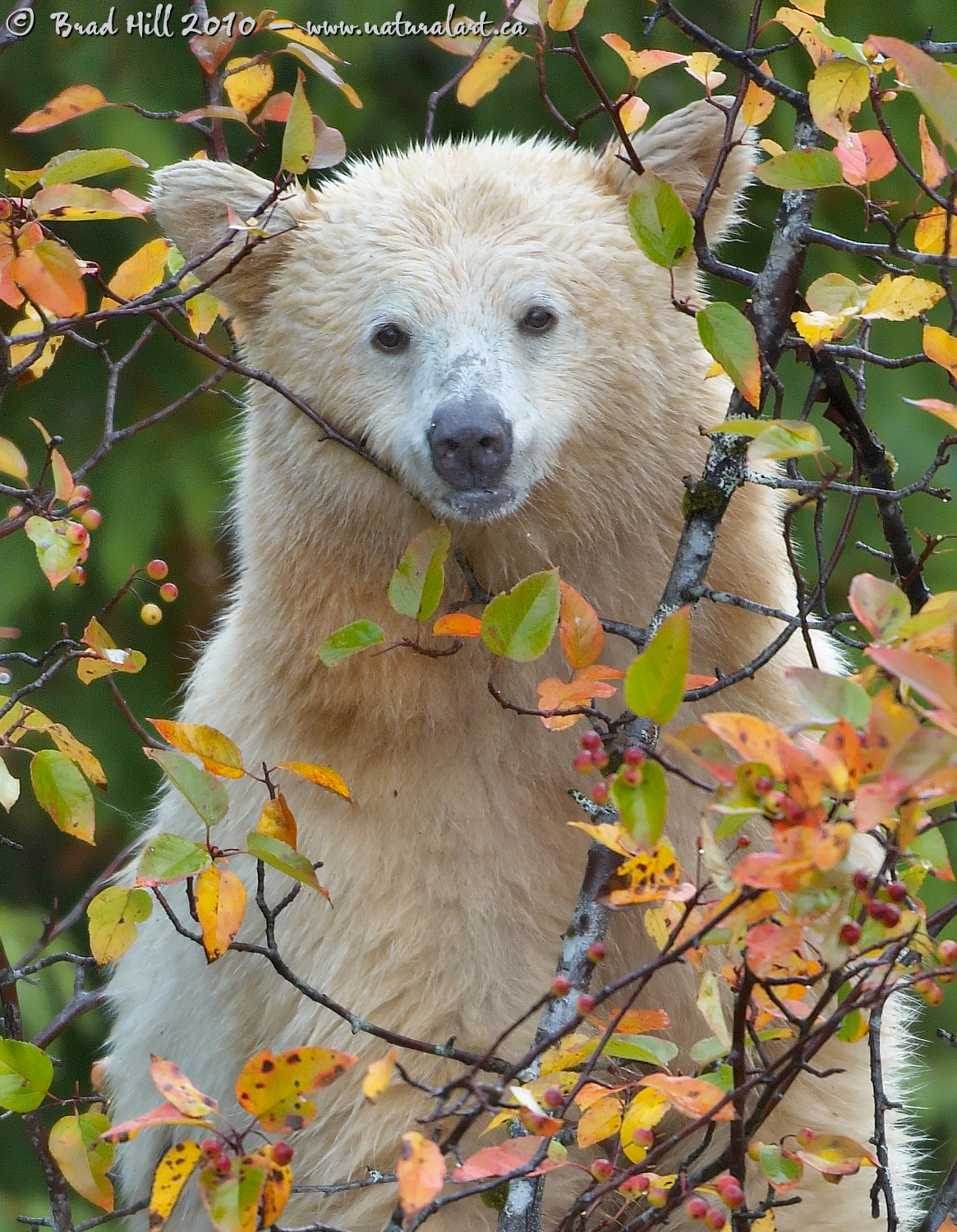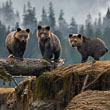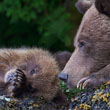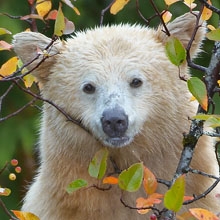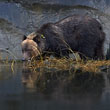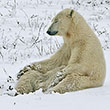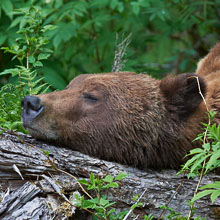Availability: Undetermined - Enquiries?
In the Field
The Eyes of a Spirit. Great Bear Rainforest (northern BC coast), Canada. October 11, 2007.
I rarely say this about my own photography - but I love this shot! I'm not sure if it's the eyes or the chin resting on the branch or a little of both...but it works for me.
Catching an animal's eyes correctly can make or break a wildlife photo. This means ensuring they're in sharp focus (I often position my camera's focus brackets on one of their eyes) and, whenever possible, catching reflections in their eyes (commonly known as "catch lights"). The contrast between the light coat colour of Spirit Bears and the darkness of their eyes make them particularly appealing (and critical to your photograph). If you ever get the chance to photograph these rare bears, remember how important those eyes are!
ADDITIONAL NOTES:
1. This image - in all resolutions - is protected by copyright. I'm fine with personal uses of them (including use as desktop backgrounds or screensavers on your own computer), but unauthorized commercial use of the image is prohibited by law. Thanks in advance for respecting my copyright!
2. This image was captured during one of my autumn "Into the Great Bear Rainforest" photo tours in 2007. Each year I offer trips into two different parts of the Great Bear Rainforest as well as one to photograph marine mammals and oceanscapes near the northern tip of Vancouver Island. And, in selected years, I also offer photo tours to additional locations to capture other highly sought-after subjects, such as various boreal owl species, fishing grizzlies, and more. Details about these trips can be found on the Photo Tours page of this website.
3. Like all wildlife images on this website, the subject(s) is/are fully wild and completely unconstrained. Besides the potential impact of my/our presence, nothing has been done to intentionally alter or affect the ongoing behavior of the subject and, of course, there has been no use of any form of bait or other form of wildlife attractants (including vocalizations or other sounds).
Behind the Camera
The Eyes of a Spirit. Great Bear Rainforest (northern BC coast), Canada. October 11, 2007.
Digital Capture; Uncompressed RAW (NEF) format; ISO 250.
Nikon D2X with Nikon 200-400 mm f/4G ED-IF AF-S VR lens @ 310 mm (465 mm equivalent with digital conversion factor) supported on Gitzo 1348 carbon fibre tripod with Wimberley head - all on deck of moving sailboat. VR turned to "On" and in "Normal" mode. AquaTech SportShield (rain cover) used to protect camera and lens.
1/250s @ f4; -0.33 stop compensation from matrix-metered exposure setting.
At the Computer
The Eyes of a Spirit. Great Bear Rainforest (northern BC coast), Canada. October 11, 2007.
RAW Conversion to 16 bit TIFF, including first-pass sharpening and exposure compensation using Phase One's C1 Pro.
Further digital correction on 16-bit TIFF file using Adobe's Photoshop CS3 and LightZone 3. Minor tonal adjustments performed in LightZone (using the ToneMapper/Relight tool). Photoshop adjustments included selective saturation enhancement and selective sharpening for web output.
Conservation
The Eyes of a Spirit. Great Bear Rainforest (northern BC coast), Canada. October 11, 2007.
Ten percent of the revenue generated by this image will be donated to Raincoast*.
Species Status in Canada**: Not currently listed as Threatened or Endangered.
The "Spirit" Bear is a rare genetically-based colour variant of the common Black Bear (Ursus americana). It has been estimated that less than 300 Spirit Bears exist today. Because the Black Bear is not considered under threat as a species, the Spirit Bear suffers from having the same conservation designation (it should be acknowledged that in British Columbia - the jurisdiction of greatest Spirit Bear abundance - hunting of these white-coated bears is not permitted). For reasons that are not fully understood, the Spirit Bear occurs with greater frequency in a relatively small geographic area within The Great Bear Rainforest of the central and northern coast of British Columbia. In this area 10 to 30% of the bears possess white coats. Many of the black-coloured Black Bears in this region carry the gene for white coats, so allowing hunting of ANY Black Bears in this region can reduce the frequency of the gene for white coats. Thus, to protect the Spirit Bear, it is necessary to prohibit the hunting of ALL Black Bears in this region. And, very unfortunately, the globally unique ecosystem that contains the Spirit Bear is under development pressure, especially from the forestry industry. If this unique environment is altered, we may lose the wonderful genetic anomaly known as the Spirit Bear forever.
*The Raincoast Conservation Society (and Foundation) is an effective and efficient organization that has been fighting for protection of this unique habitat. If you are looking for a meaningful way to contribute to the conservation of this amazing ecosystem, Raincoast will provide maximal "bang" for your conservation dollars.
**as determined by COSEWIC: The Committee on the Status of Endangered Wildlife in Canada












